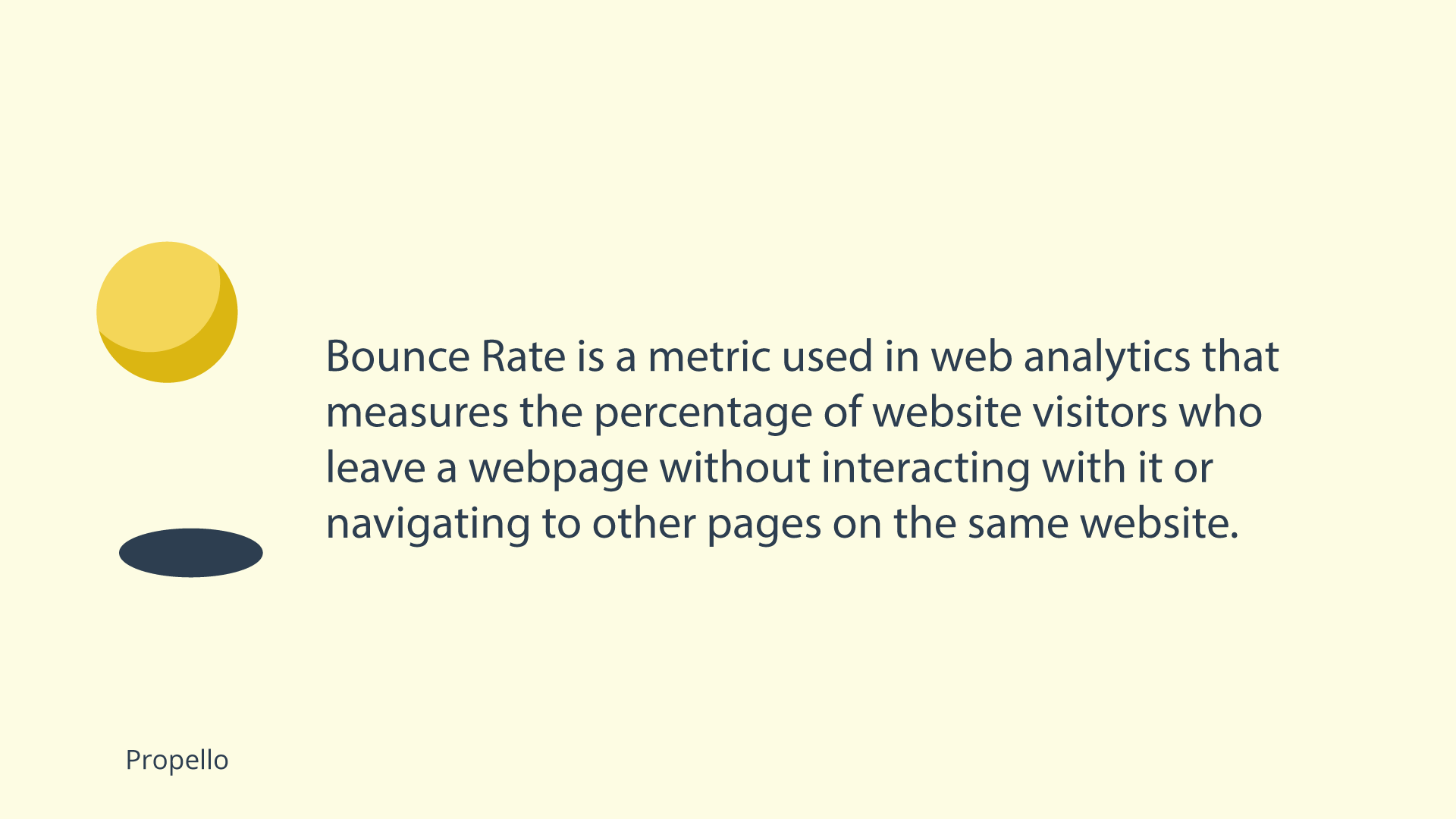Have you ever heard the term "bounce rate" and wondered what it means? If you have a website or are involved in online marketing, understanding this metric is crucial to your success.
In the world of digital marketing, bounce rate is a term used to describe the percentage of visitors who leave a website after only viewing one page. This metric is important because it can indicate whether or not your website is engaging and relevant to your target audience.
In this article, we will explore what bounce rate is, why it matters, and how you can improve it. Whether you're a website owner, marketer, or simply curious about online metrics, understanding bounce rate is a key component of online success.
So, let's dive in and learn more about this important metric.
|
Bounce Rate Bounce Rate is a metric used in web analytics that measures the percentage of website visitors who leave a webpage without interacting with it or navigating to other pages on the same website. |
What is Bounce Rate?
The bounce rate of your website is the percentage of users who land on a page of your website and then leave that page. They take no other action, nor do they click on anything else or visit the second page of the site.

Remember, the bounce rate is not the same as the exit rate. Bounce rate only measures "one-time" visits - visits where people enter and leave your site without visiting a single page on your site. For example, this is how they look in your HubSpot web analytics dashboard:
Exit rates, on the other hand, are a bit more complicated. They include the percentage of people who leave your site from a particular page - but that's not necessarily the only page they visit on your site. The page they left off could be the last in a long list of page views. So exit rates aren't always as worrisome as bounce rates.
Why is Bounce Rate Important?
A bounced visitor is a missed opportunity, a visitor who makes a digital journey on your website and then leaves without taking an action.
When it comes to digital marketing, user engagement is very important. Even with millions of visits per day, if they don't lead to a single conversion, it is not profitable.
Bounce rate matters because optimization matters. Companies leading in the digital space are not necessarily those with the biggest investments, but those who can convert as many visitors as possible into paying customers relative to their budget.
If you can make an impeccable first impression, you make them stay. These users feel the need to explore your website, your content, and your brand. Every new page they visit is one step closer to converting.
Users who stay longer on your site are more likely to come back regularly. They make it a habit, which leads to sales, brand awareness, and loyalty.
A good bounce rate reduction strategy can push businesses to use the same digital plans and budgets they already have to increase conversion rates. It's a faster and easier way to expand your reach.
As mentioned earlier, your bounce rate is important. A poor bounce rate can mean a poor user experience and a drop in website sales for users who leave your website. Knowing your bounce rate is crucial to optimizing your website's conversion rate.
How to Calculate the Bounce Rate
Considering that a bounce rate is the percentage of website visitors who view only one page of your site, it is calculated by dividing the total number of unique visits to a page by the total number of visitors.
For example, if 1000 people visit your website and 100 of them only visit one page, then your bounce rate is 10%. This number can change over time, so it's helpful to track any changes with an analytics provider to understand what's affecting your bounce rate.
What Is a Good Bounce Rate?
If you've looked at your site's bounce rate recently, you might be frustrated by this number. However, if you then decide to aim for a 0% bounce rate, you may be even more disappointed. The average bounce rate is between 26% and 70%, with an optimal range between 26% and 40%. Landing anywhere below 20% is usually close to impossible. So if your data shows this, there are a few things you should double-check. Duplicate code, incorrectly implemented tracking, and third-party plugins can all contribute to inaccurate bounce rate reporting.
The average bounce rate can also vary depending on the viewer's device. For example, mobile has the highest bounce rate of any industry at 51%. The average bounce rate for desktops is 43%, and the average bounce rate for tablets is 45%. So, when evaluating your site's bounce rate, consider the source of your traffic as well.
High Bounce Rate
A bounce rate of over 70% is above average, but not necessarily high until it hits 56%. If it's over 90%, it's a big worry, but it's usually easy to lower because there's something specific that turns everyone away. Issues like poor design, bugs in tracking code, too many bots, or browser incompatibilities can be the culprits. Also, note that high traffic from social media or paid ads and lots of mobile visitors will also increase your bounce rate.
How to Reduce High Bounce Rates
Now you know what a bounce rate is. But what can you actually do to make sure that it is as low as possible?
Generally, a high bounce rate can indicate that the page is irrelevant or confusing to website visitors. But don't take immediate drastic measures like removing pages or redesigning them. There are a few important steps you need to take before you decide what action to take.
Remember, bounce rate only tells you that someone lands on a page and leaves without visiting any other pages on your site. It doesn't tell you how someone interacts with your page. That's why it's important, to take practical steps to examine other website metrics and parts of your site to understand what's behind bounce rates.
Here are a few things to look at when taking action to reduce your website bounce rate:
1. Make sure your website is mobile-friendly.
Global web traffic on mobile phones has surged over the past decade. According to Oberlo, 59.4% of all web traffic came through mobile phones. Mobile phone use is only going to rise, and this upward trajectory is a clear indication that the mobile user experience is crucial to your digital marketing success.
If your website is not mobile-friendly, you will lose out on a significant portion of global traffic. By ensuring your website is mobile-friendly, you’re giving potential customers a better user experience and allowing them to access your products or services on their phones or tablets.
This will increase sales and also help you to reach new audiences.
2. View your bounce rate based on different sources.
Sometimes the source that drives traffic to a particular page is related to the bounce rate. That's why you can use the HubSpot web analytics dashboard to segment bounce rates by source:
Let's assume your direct traffic has a particularly high bounce rate - look at the URL carefully to make sure it's easy to read, remember, and type. Then check if the visitor doesn't get a 404 error or a less attractive homepage. Titles should be clear and let people know they've come to the right place.
Regardless of the source, you must meet the expectations of your visitors.
3. Avoid other distractions that may affect the user experience.
We've discussed the importance of a good mobile user experience, and this applies to all platforms. Things like fullscreen popups are not only annoying, but they can also lead to search engine penalties. This will also affect your SEO ranking on search engines.
The most important thing to consider is the user experience. You want visitors to be drawn to your page and stay for the time it takes to convert. Although some popups are fine (well-crafted inbound copy with context), try to avoid ones that can wreak havoc on the user experience and drive visitors away.
4. Determine which keywords this page ranks for
Remember how we warned against misleading visitors about your site's social media content? The same goes for keyword rankings. Aligning keyword intent with your content is important to ensure that organic visitors get the content they expect.
If you’re looking for the best keywords for your site, pay attention to what people are searching for. You can also use tools like Ahrefs or SEMrush to uncover the most popular keyword terms that bring visitors to your website.
Check for broken links, because they are one of the most common issues on websites today, but they can be difficult to find if you don't know where If you find that the page isn’t ranking for any of your target keywords, then it may be time to reevaluate your SEO strategy.
Start Reducing your Bounce Rate
When examining bounce rate, make sure you're looking at the bigger picture. See how much time users spend on your site, where they're coming from, and what device they're using — and whether your content and experience fit all of these factors. You may find patterns that show how to fix the bounce rate problem.
Think of bounce rate as a symptom in your body, like a headache. If it continues, you'll know there may be a problem - but you'll need to check with the doctor to accurately diagnose the problem. There is no blanket approach to bounce rates, but understanding what bounce rates are and how they affect your inbound marketing strategy can help ensure your website is a success.



%20is%20Important.png)
%20Examples/Conversion%20Rate%20Optimization%20(CRO)%20Examples.png)
